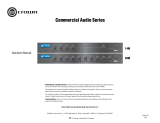Biamp autoTWO Automatic Mixer User manual
- Category
- Mixers
- Type
- User manual
This manual is also suitable for
Biamp autoTWO Automatic Mixer is a high-quality, versatile device that provides automatic mixing of up to eight balanced mic/line inputs. The autoTWO features a wide range of capabilities that make it ideal for a variety of applications, including sound reinforcement, broadcast, and recording. Some of the key features of the autoTWO include:
- Adaptive Threshold Sensing to minimize false gate triggering.
- Speech-Frequency Filtering to minimize false gating due to noise.
- 6dB of hysteresis to reduce gate ‘flutter’ when near threshold. *Selectable channel-off attenuation (-12dB or -40dB). *Selectable last mic on, HPF, automix, & 48V phantom power.
Biamp autoTWO Automatic Mixer is a high-quality, versatile device that provides automatic mixing of up to eight balanced mic/line inputs. The autoTWO features a wide range of capabilities that make it ideal for a variety of applications, including sound reinforcement, broadcast, and recording. Some of the key features of the autoTWO include:
- Adaptive Threshold Sensing to minimize false gate triggering.
- Speech-Frequency Filtering to minimize false gating due to noise.
- 6dB of hysteresis to reduce gate ‘flutter’ when near threshold. *Selectable channel-off attenuation (-12dB or -40dB). *Selectable last mic on, HPF, automix, & 48V phantom power.














-
 1
1
-
 2
2
-
 3
3
-
 4
4
-
 5
5
-
 6
6
-
 7
7
-
 8
8
-
 9
9
-
 10
10
-
 11
11
-
 12
12
-
 13
13
-
 14
14
Biamp autoTWO Automatic Mixer User manual
- Category
- Mixers
- Type
- User manual
- This manual is also suitable for
Biamp autoTWO Automatic Mixer is a high-quality, versatile device that provides automatic mixing of up to eight balanced mic/line inputs. The autoTWO features a wide range of capabilities that make it ideal for a variety of applications, including sound reinforcement, broadcast, and recording. Some of the key features of the autoTWO include:
- Adaptive Threshold Sensing to minimize false gate triggering.
- Speech-Frequency Filtering to minimize false gating due to noise.
- 6dB of hysteresis to reduce gate ‘flutter’ when near threshold. *Selectable channel-off attenuation (-12dB or -40dB). *Selectable last mic on, HPF, automix, & 48V phantom power.
Ask a question and I''ll find the answer in the document
Finding information in a document is now easier with AI
Related papers
-
Biamp 301 & 601 User manual
-
Biamp DP-M28 Operation User manual
-
Biamp 801i Mic/Line Mixer User manual
-
Biamp SPM412e User manual
-
Biamp IWA250 User manual
-
Biamp AUTOONE User manual
-
Biamp 801I User manual
-
Biamp 801 Operation User manual
-
Biamp Advantage System One Modular Mixing System Operation User manual
-
Biamp AUDIAFUSION User manual
Other documents
-
Electro-Voice 2509 User manual
-
 Crown Audio 28M User manual
Crown Audio 28M User manual
-
QSC PL230 (D) User manual
-
Yamaha P2050 Owner's manual
-
Phonic XP 5000 User manual
-
Crown DSi 6000 Owner's manual
-
Yamaha SP2060 Owner's manual
-
Yamaha SP2060 Owner's manual
-
QSC RMX 1450 Owner's manual
-
Arcam Home Theater System AVR250 User manual














